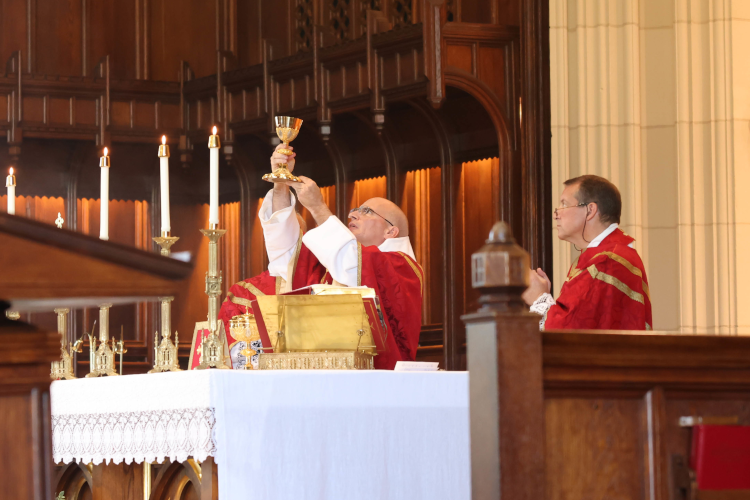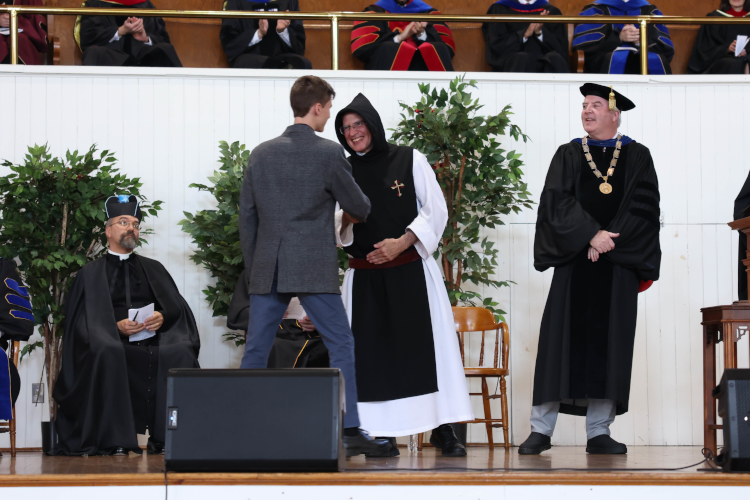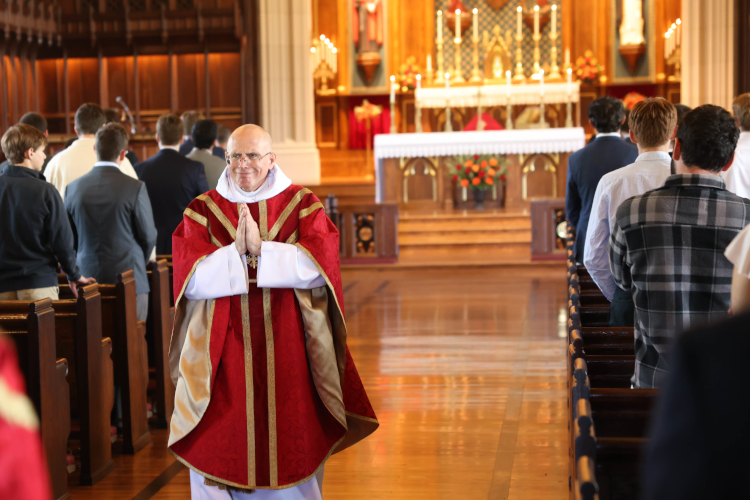- Home
-
About
 Fidelity & Excellence
Fidelity & ExcellenceThomas Aquinas College is unique among American colleges and universities, offering a faithfully Catholic education comprised entirely of the Great Books and classroom discussions.
-
A Liberating Education
 Truth Matters
Truth MattersTruth, and nothing less, sets men free; and because truth is both natural and supernatural, the College’s curriculum aims at both natural and divine wisdom.
-
A Catholic Life
 Under the Light of Faith
Under the Light of FaithThe intellectual tradition and moral teachings of the Catholic Church infuse the whole life of Thomas Aquinas College, illuminating the curriculum and the community alike.
-
Admission & Aid
 Is TAC Right for You?
Is TAC Right for You?Do you enjoy grappling with complex questions? Are you willing to engage in discussions about difficult concepts, with the truth as your ultimate goal?
-
Students & Parents
 Mind, Body & Spirit
Mind, Body & SpiritThere is always something to do at TAC — something worthwhile, something fulfilling, and something geared toward ever-greater spiritual and intellectual growth.
-
Alumni & Careers
 What Can You Do with a Liberal Education?
What Can You Do with a Liberal Education?Nothing speaks more to the versatility of the College’s academic program than the good that our alumni are doing throughout the Church and the world.
- Search
- Giving
Engineer, Monk, Founder: Rev. Joseph O’Hara (’92)

“Thomas Aquinas College set me down a path of intellectual awakening,” says Rev. Joseph O’Hara (’92), founder of Holy Family Monastery in Ferndale, California and an avid student of St. Thomas. In August, he served as the College’s Convocation Speaker in New England, where he shared his great love for his alma mater and years of wisdom with the incoming Class of 2028. “I’m convinced that Thomas Aquinas College can teach how to engage the intellect in a simple yet highly effective way.”
Fr. O’Hara studied electrical engineering at the University of Wisconsin-Platteville and went on to work at NASA’s Jet Propulsion Laboratory in Pasadena, California, after his graduation in 1986. However, he often found himself at Thomas Aquinas College visiting his two younger siblings, Mary (Cain (87) and Marty O’Hara, Sr. (’88).
“It was immediately manifest to me that they had something I didn’t,” the monk observes. After engaging in long conversations about theology and philosophy with his siblings and their friends, he attempted to study these topics on his own, picking up a graduate-level philosophy class at Northern Illinois University and studying the Platonic dialogues. “I would open up the book, read the text, attend the class, and still not understand what Plato was saying. I would get enough of a glimpse to see there was something deeper there, but I wasn’t able to comprehend it on my own.”
Knowing that he could only get so far pursuing philosophy without assistance, Fr. O’Hara left his career in engineering behind to enroll as a freshman at Thomas Aquinas College. “I had an educational awakening,” he says. “I liked my work as an engineer, but I found that studying the Great Books carried greater dignity and was far more valuable to me.”
In his junior year, Fr. O’Hara attended a retreat at Christ in the Mountains Monastery, led by Fr. Leo Slatterie, a Trappist hermit. “Fr. Leo told me, ‘I think I see a monastic vocation in you,’ and I laughed at time,” he recalls. “But after a lot of reflection and a second retreat, I realized that I enjoyed living the monastic, contemplative life. It was simply a continuation of what I was doing at the College, and I wanted nothing more than to continue growing and learning in the same way.”

After graduation, he returned to Christ in the Mountains Monastery, where he spent four years in formation with Fr. Leo. In 1996, he asked His Eminence Raymond Leo Cardinal Burke, then the Bishop of La Crosse, for permission to start his own monastery on his family farm in Wisconsin. The Bishop recommended Fr. O’Hara become a priest first, sending him to the Pontifical College Josephinum in Columbus, Ohio. Five years later, Bishop Burke ordained Fr. O’Hara to the priesthood for the Diocese of La Crosse, which he served for the following 12 years.
Before returning to his plans to found a monastery, Fr. O’Hara made various visits to Clear Creek Abbey in Oklahoma. “I initially asked for a ‘refresher course’ to help me get back into monastic rhythm after the 12 years ministering in the Diocese, but was invited to join them,” he says. Although he spent eight fruitful years at the Abbey, he longed for the intellectual approach that he had experienced at Thomas Aquinas College.
“Many scholars try to reconcile the teachings of the moderns with what St. Thomas says, rather than stick with the truths found in the original works of St. Thomas and Aristotle,” he explains. “As a result, the intellectual custom of every single monastery is different, based on whose teaching they follow. I wanted to create a monastery that follows the three-pronged anchor of austere Cistercian monastic life, the traditional Latin liturgy, and the intellectual custom of Thomas Aquinas College, where the intellect is engaged specifically in knowing and delighting in truth for its own sake, following the teachings of the Angelic Doctor.”
Fr. O’Hara’s bishop recommended he seek potential opportunities in the Diocese of Santa Rosa, California, under the leadership of His Excellency Robert Vasa. With the Bishop’s permission, Fr. O’Hara finally launched his monastery in the city of Ferndale, outfitting a farmhouse with a garden and woodshop and offering Mass in the extraordinary form for the local community.
“I didn’ t want to be completely separate from the laypeople,” he says. “I wanted to recreate the kind of community found in medieval Europe, where the monasteries were at the heart of a city. Just the presence of the monks and the ability to attend some of their liturgies gave the rest of the town a strong foundation, and I saw that as the ideal.”
The concept of family is important to Fr. O’Hara, who named his new monastery after the Holy Family, the ideal which every good family strives to emulate. “Family has both the joy of being together and the element of mercy to help each bring each other to the good,” he says. “The name refers both to Jesus’s Holy Family and the need for holy family life in the Church. I am convinced that right now we are in an age when family life needs the most attention. We must recognize that, while it is in family that we face the greatest struggles and hardships, it is also in family that we receive the most help from God.”


